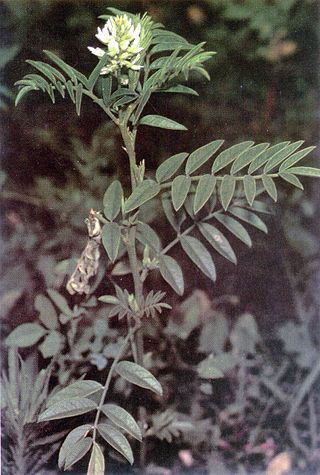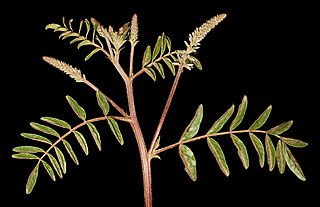
Liquorice or licorice is the common name of Glycyrrhiza glabra, a flowering plant of the bean family Fabaceae, from the root of which a sweet, aromatic flavouring can be extracted.

Glycyrrhiza is a genus of about 20 accepted species in the legume family (Fabaceae), with a subcosmopolitan distribution in Asia, Australia, Europe, and the Americas.

Glycyrrhiza lepidota is a species of Glycyrrhiza native to most of North America, from central Canada south through the United States to California, Texas and Virginia, but absent from the southeastern states. It is also sometimes known in the United States as "wild licorice", to distinguish it from the related European licorice which is occasionally cultivated.

Species Plantarum is a book by Carl Linnaeus, originally published in 1753, which lists every species of plant known at the time, classified into genera. It is the first work to consistently apply binomial names and was the starting point for the naming of plants.

Glycyrrhizol A is a prenylated pterocarpan and an isoflavonoid derivative. It is a compound isolated from the root of the Chinese licorice plant.

Glycyrrhiza uralensis, also known as Chinese liquorice, is a flowering plant native to Asia. It is used as a sweetener and in traditional Chinese medicine.

Polypodium glycyrrhiza, commonly known as licorice fern, many-footed fern, and sweet root, is a summer deciduous fern native to western North America, where it is found in shaded, damp locations.
Shennong Bencaojing is a Chinese book on agriculture and medicinal plants, traditionally attributed to Shennong. Researchers believe the text is a compilation of oral traditions, written between about 206 BC and 220 AD. The original text no longer exists, but is said to have been composed of three volumes containing 365 entries on medicaments and their description.

Ononin is an isoflavone glycoside, the 7-O-β-D-glucopyranoside of formononetin, which in turn is the 4'-O-methoxy derivative of the parent isoflavone daidzein.

Licochalcone A is a chalconoid, a type of natural phenol. It can be isolated from the root of Glycyrrhiza glabra (liquorice) or Glycyrrhiza inflata. It shows antimalarial, anticancer, antibacterial and antiviral properties in vitro.
Glycyrrhiza inflata is a plant species in the genus Glycyrrhiza from China, with common name Chinese licorice. A related species, G. uralensis, however, is more likely the licorice species one finds in traditional Chinese medicine.

Glabridin is a chemical compound that is found in the root extract of licorice. Glabridin is an isoflavane, a type of isoflavonoid. This product is part of a larger family of plant-derived molecules, the natural phenols. Glabridin effectively inhibits platelet activation, so it might become therapeutic agent for thromboembolic disorders.

Glycyrrhiza acanthocarpa, with the common names native liquorice, and southern liquorice is a subshrub in the pea family, Fabaceae. The species is native to Australia. It grows to between 0.1 and 1 metre high. Narrow purple flowers appear between September and May in the species native range.

Liquiritigenin is a flavanone that was isolated from Glycyrrhiza uralensis, and is found in a variety of plants of the Glycyrrhiza genus, including Glycyrrhiza glabra (licorice). It is an estrogenic compound which acts as a selective agonist of the ERβ subtype of the estrogen receptor (ER), though it is also reported to act as an ERα partial agonist at sufficient concentrations. It also has a choleretic effect.
Liquorice or licorice is the root of Glycyrrhiza glabra from which a somewhat sweet flavor can be extracted.

Glycyrrhiza echinata is a species of flowering plant in the genus Glycyrrhiza, with various common names that include Chinese licorice, German licorice, and hedgehog licorice, Eastern European licorice, Hungarian licorice, Prickly licorice, and Roman licorice. It is used as a flavoring and medicinally, and to produce Russian and German licorice.

Mesir Macunu is a traditional Turkish sweet associated with the city of Manisa. Earlier versions of Mesir macunu were not sweet, but rather spicy in flavor.
Glycyrrhiza aspera, is a plant species in the pea family, Fabaceae, native to Asia and eastern Europe. It is used to make a tea.
Glycyrrhiza yunnanensis, is a plant species in the pea family, Fabaceae, native to China.
Pseudoclavibacter endophyticus is a Gram-positive, aerobic, rod-shaped and non-motile bacterium from the genus Pseudoclavibacter which has been isolated from the roots of the plant Glycyrrhiza uralensis from Yili County in China.













